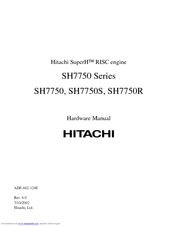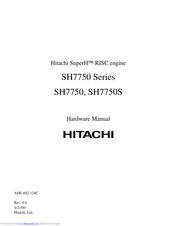Hitachi SH7750S SuperH Risc Engine Manuals
Manuals and User Guides for Hitachi SH7750S SuperH Risc Engine. We have 2 Hitachi SH7750S SuperH Risc Engine manuals available for free PDF download: Hardware Manual
Hitachi SH7750S Hardware Manual (1037 pages)
SH7750 Series SuperH RISC engine
Table of Contents
-
-
Overview51
-
Data Formats91
-
Index94
-
Processor States104
-
Processor Modes105
-
Overview107
-
Features107
-
Role of the MMU107
-
Caution110
-
-
Address Space114
-
TLB Functions121
-
MMU Functions128
-
MMU Exceptions131
-
-
Caches145
-
Overview145
-
-
Configuration149
-
Read Operation153
-
Write Operation154
-
RAM Mode156
-
OC Index Mode157
-
Configuration158
-
Read Operation161
-
IC Index Mode161
-
-
-
IC Address Array167
-
IC Data Array168
-
OC Address Array169
-
OC Data Array170
-
-
Store Queues172
-
Exceptions177
-
Overview177
-
Exception Flow182
-
Usage Notes209
-
Restrictions210
-
Data Formats211
-
Overview211
-
Registers215
-
Rounding218
-
Instruction Set223
-
Addressing Modes225
-
Instruction Set229
-
Pipelines243
-
Pipelining243
-
Overview271
-
Power-Down Modes271
-
Deep Sleep Mode280
-
Sleep Mode280
-
Standby Mode281
-
-
In Reset287
-
-
Overview297
-
Features297
-
-
Overview of CPG299
-
-
Using the WDT313
-
Overview317
-
Features317
-
Block Diagram318
-
-
-
(SH7750R Only)333
-
Operation335
-
Interrupts339
-
Usage Notes339
-
Overview341
-
Features341
-
Block Diagram342
-
-
Operation354
-
Interrupts358
-
Usage Notes359
-
Overview361
-
Features361
-
Block Diagram363
-
PCMCIA Support372
-
-
-
Operation420
-
Areas432
-
SRAM Interface437
-
DRAM Interface445
-
-
PCMCIA Interface494
-
MPX Interface505
-
Overview539
-
Operation560
-
Examples of Use594
-
-
-
Usage Notes641
-
Overview643
-
Features643
-
Block Diagram645
-
-
-
Operation671
-
Overview671
-
-
Usage Notes702
-
Overview707
-
Features707
-
Block Diagram709
-
-
-
Operation735
-
Usage Notes748
-
Overview753
-
Operation760
-
Overview760
-
Pin Connections761
-
Data Format762
-
Clock765
-
-
Usage Notes775
-
Overview781
-
Overview801
-
Features801
-
Block Diagram801
-
-
-
NMI Interrupt804
-
IRL Interrupts805
-
-
-
INTC Operation818
-
Overview823
-
Features823
-
Block Diagram824
-
-
-
Operation835
-
Usage Notes842
-
Examples of Use845
-
Overview849
-
Features849
-
Block Diagram849
-
-
-
Operation860
-
Usage Notes862
-
-
-
Bus Timing921
-
CAS Latency = 3)938
-
-
Pin States1001
-
Hd6417750Sbp2001029
-
Advertisement
Hitachi SH7750S Hardware Manual (858 pages)
SuperH RISC engine
Table of Contents
-
Overview18
-
Data Formats26
-
Overview42
-
Memory Space49
-
Caches78
-
Overview78
-
-
-
Store Queues96
-
Exceptions99
-
Overview99
-
Exception Flow104
-
-
Resets108
-
Interrupts127
-
-
Usage Notes131
-
Restrictions132
-
Overview133
-
Data Formats133
-
Registers137
-
Rounding140
-
Instruction Set145
-
Addressing Modes147
-
Instruction Set151
-
Pipelining164
-
Pipelines164
-
Power-Down Modes191
-
Overview191
-
Sleep Mode198
-
Deep Sleep Mode198
-
Standby Mode199
-
Overview210
-
Features210
-
-
Overview of CPG212
-
-
-
Block Diagram221
-
-
Using the WDT225
-
Overview229
-
Features229
-
Block Diagram230
-
-
-
Operation246
-
Interrupts250
-
Usage Notes250
-
Overview252
-
Features252
-
Block Diagram253
-
-
Operation262
-
Interrupts266
-
Usage Notes267
-
Overview268
-
Features268
-
Block Diagram270
-
PCMCIA Support279
-
-
-
Operation320
-
Areas331
-
Basic Interface335
-
DRAM Interface343
-
PCMCIA Interface388
-
MPX Interface399
-
Overview430
-
Features430
-
Block Diagram432
-
-
Operation450
-
Examples of Use484
-
Usage Notes513
-
Overview514
-
Features514
-
Block Diagram516
-
Advertisement

